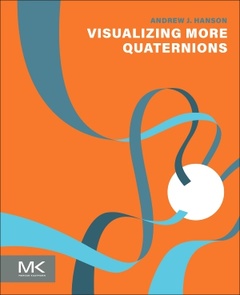Description
Visualizing More Quaternions
Author: Hanson Andrew J.
Language: English
Subject for Visualizing More Quaternions:
Keywords
Quaternion; global protein orientation-frame structure; Root Mean Square Deviation (RMSD); Quaternion Frame Alignment (QFA); robotics hand-eye matching; protein structures; machine vision multicamera alignment; 6 degree of freedom motion alignment; Quaternion Barycenter; Cryo-Electron-Microscopy; deep AI; Machine Learning; Quaternion differential geometry; Quaternion projective geometry; invariant cross-ratios; Special Relativity; complexified quaternions; relativistic spinning top dynamics; Skyrmions; Kleinian Groups; Clifford Algebras
594 p. · 19x23.3 cm · Paperback
Description
/li>Contents
/li>Biography
/li>Comment
/li>
2. Synopsis of Useful Applications of Quaternions
3. Quaternion maps of global protein orientation-frame structure
4. Quaternion methods for the Root Mean Square Deviation (RMSD) problem
5. Quaternion methods for the Quaternion Frame Alignment (QFA) problem for 3D molecular and protein structures
6. Quaternion methods for the RMSD coordinate matching problem in 4D
7. Quaternion methods for Quaternion Frame Alignment QFA of molecular and protein structures in 4D
8. Quaternion methods for the robotics hand-eye matching problem
9. Quaternion methods for the machine vision multicamera alignment problem
10. Elements and applications of Dual Quaternions for 6 degree-of-freedom motion analysis
11. Bar-Itzhack method for finding quaternions from numerical rotation matrices
12. Methods for calculating the quaternion barycenter
13. Quaternion frame approach to Cryo-Electron-Microscopy
14. Extraction of quaternion camera viewpoint information from 3D data using deep AI and machine learning methods
15. Quaternion projective geometry and invariant cross-ratios
16. Special Relativity using complexified quaternions18. Relativistic spinning top dynamics with quaternions
17. Skyrmions in Quaternion Form
18. Quaternion maps of the Kleinian Groups
19. Extension of quaternion shape matching methods in 3D and 4D to arbitrary dimension N using Clifford Algebras
20. Conclusion and Philosophical Remarks on Quaternions
- Establishes basic principles for visual display of quaternions and their applications.
Explores quaternion based approaches to the matching of point cloud pairs, as well as data from orthographic and perspective projections.
Develops extensive applications of quaternion frames to protein orientation analysis.
Analyzes the application of quaternion methods to physics problems ranging from quantum computing to special relativity and gravitational instantons.

